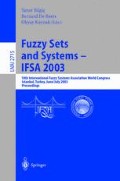Abstract
In this paper, we study the Ferrers property of relations in the context of fuzzy preference modelling. A logical approach leads us to the notion of T-Ferrers relations, while a relational approach brings us to T-biorders. We characterize the t-norms for which both notions coincide. We also describe the kind of completeness exhibited by reflexive T-Ferrers relations or reflexive T-biorders. Finally, we investigate the relationship between the T-Ferrers properties of a reflexive fuzzy relation R and the corresponding strict preference relation P, and the relationship between R and P being T-biorders.
Access this chapter
Tax calculation will be finalised at checkout
Purchases are for personal use only
Preview
Unable to display preview. Download preview PDF.
References
B. De Baets and J. Fodor, Twenty years of fuzzy preference structures (1978–1997), JORBEL 37 (1997), 61–82.
B. De Baets and J. Fodor, Generator triplets of additive fuzzy preference structures, Proc. Sixth Internat. Workshop on Relational Methods in Computer Science (Tilburg, The Netherlands), 2001, pp. 306–315.
B. De Baets and B. Van de Walle, Weak and strong fuzzy interval orders, Fuzzy Sets and Systems 79 (1996), 213–225.
B. De Baets, B. Van de Walle and E. Kerre, Fuzzy preference structures without incomparability, Fuzzy Sets and Systems 76 (1995), 333–348.
K. Demirli and B. De Baets, Basic properties of implicators in a residual framework, Tatra Mt. Math. Publ. 16 (1999), 31–46.
J.-P. Doignon, B. Monjardet, M. Roubens and Ph. Vincke, Biorder families, valued relations, and preference modelling, J. Math. Psych. 30 (1986), 435–480.
J. Fodor, Traces of binary fuzzy relations, Fuzzy Sets and Systems 50 (1992), 331–341.
J. Fodor, A new look at fuzzy connectives, Fuzzy Sets and Systems 57 (1993), 141–148.
J. Fodor, Contrapositive symmetry of fuzzy implications, Fuzzy Sets and Systems 69 (1995), 141–156.
J. Fodor and M. Roubens, Fuzzy Preference Modelling and Multicriteria Decision Support, Kluwer Academic Publishers, 1994.
S. Jenei, Geometry of left-continuous triangular norms with strong induced negations, JORBEL 98 (1998), 5–16.
S. Jenei, New family of triangular norms via contrapositive symmetrization of residuated implications, Fuzzy Sets and Systems 110 (2000), 157–174.
S. Jenei, Structure of left-continuous triangular norms with strong induced negations. (I) Rotation construction, J. Appl. Non-Classical Logics 10 (2000), 83–92.
S. Jenei, Structure of left-continuous triangular norms with strong induced negations. (II) Rotation-annihilation construction, J. Appl. Non-Classical Logics 11 (2001), 351–366.
S. Jenei, Structure of left-continuous triangular norms with strong induced negations. (III) Construction and decomposition, Fuzzy Sets and Systems 128 (2002), 197–208.
E.-P. Klement, R. Mesiar and E. Pap, Triangular Norms, Trends in Logic, Studia Logica Library, Vol. 8, Kluwer Academic Publishers, Dordrecht, 2000.
B. Monjardet, Axiomatiques et propriétés des quasi-ordres, Math. Sci. Hum. 63 (1978), 51–82.
M. Roubens and Ph. Vincke, Preference modelling, Lecture Notes in Economics and Mathematical Systems, Vol. 76, 1995.
Author information
Authors and Affiliations
Editor information
Editors and Affiliations
Rights and permissions
Copyright information
© 2003 Springer-Verlag Berlin Heidelberg
About this paper
Cite this paper
Díaz, S., De Baets, B., Montes, S. (2003). T-Ferrers Relations versus T-biorders. In: Bilgiç, T., De Baets, B., Kaynak, O. (eds) Fuzzy Sets and Systems — IFSA 2003. IFSA 2003. Lecture Notes in Computer Science, vol 2715. Springer, Berlin, Heidelberg. https://doi.org/10.1007/3-540-44967-1_32
Download citation
DOI: https://doi.org/10.1007/3-540-44967-1_32
Published:
Publisher Name: Springer, Berlin, Heidelberg
Print ISBN: 978-3-540-40383-8
Online ISBN: 978-3-540-44967-6
eBook Packages: Springer Book Archive

